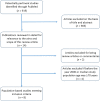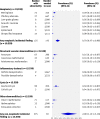Magnetic Resonance Imaging-Based Screening for Asymptomatic Brain Tumors: A Review
- PMID: 30305414
- PMCID: PMC6519753
- DOI: 10.1634/theoncologist.2018-0177
Magnetic Resonance Imaging-Based Screening for Asymptomatic Brain Tumors: A Review
Abstract
Brain tumors comprise 2% of all cancers but are disproportionately responsible for cancer-related deaths. The 5-year survival rate of glioblastoma, the most common form of malignant brain tumor, is only 4.7%, and the overall 5-year survival rate for any brain tumor is 34.4%. In light of the generally poor clinical outcomes associated with these malignancies, there has been interest in the concept of brain tumor screening through magnetic resonance imaging. Here, we will provide a general overview of the screening principles and brain tumor epidemiology, then highlight the major studies examining brain tumor prevalence in asymptomatic populations in order to assess the potential benefits and drawbacks of screening for brain tumors. IMPLICATIONS FOR PRACTICE: Magnetic resonance imaging (MRI) screening in healthy asymptomatic adults can detect both early gliomas and other benign central nervous system abnormalities. Further research is needed to determine whether MRI will improve overall morbidity and mortality for the screened populations and make screening a worthwhile endeavor.
Keywords: Asymptomatic; Brain tumor; Glioblastoma; Magnetic resonance imaging; Screening.
© AlphaMed Press 2018.
Conflict of interest statement
Disclosures of potential conflicts of interest may be found at the end of this article.
Figures




Similar articles
-
The role of early magnetic resonance imaging in predicting survival on bevacizumab for recurrent glioblastoma: Results from a prospective clinical trial (CABARET).Cancer. 2017 Sep 15;123(18):3576-3582. doi: 10.1002/cncr.30838. Epub 2017 Jul 5. Cancer. 2017. PMID: 28678383 Clinical Trial.
-
Neuroimaging of pediatric brain tumors: from basic to advanced magnetic resonance imaging (MRI).J Child Neurol. 2009 Nov;24(11):1343-65. doi: 10.1177/0883073809342129. J Child Neurol. 2009. PMID: 19841424 Review.
-
18F-fluoro-L-thymidine and 11C-methylmethionine as markers of increased transport and proliferation in brain tumors.J Nucl Med. 2005 Dec;46(12):1948-58. J Nucl Med. 2005. PMID: 16330557
-
Utility of Early Postoperative Magnetic Resonance Imaging After Glioblastoma Resection: Implications on Patient Survival.World Neurosurg. 2018 Dec;120:e1171-e1174. doi: 10.1016/j.wneu.2018.09.027. Epub 2018 Sep 12. World Neurosurg. 2018. PMID: 30218799
-
Quantitative Clinical Imaging Methods for Monitoring Intratumoral Evolution.Methods Mol Biol. 2017;1513:61-81. doi: 10.1007/978-1-4939-6539-7_6. Methods Mol Biol. 2017. PMID: 27807831 Review.
Cited by
-
Reclassification of Glioblastoma Multiforme According to the 2021 World Health Organization Classification of Central Nervous System Tumors: A Single Institution Report and Practical Significance.Cureus. 2022 Feb 1;14(2):e21822. doi: 10.7759/cureus.21822. eCollection 2022 Feb. Cureus. 2022. PMID: 35291535 Free PMC article.
-
Brain metastases: the role of clinical imaging.Br J Radiol. 2022 Feb 1;95(1130):20210944. doi: 10.1259/bjr.20210944. Epub 2021 Dec 14. Br J Radiol. 2022. PMID: 34808072 Free PMC article. Review.
-
Age, Motion, Medical, and Psychiatric Associations With Incidental Findings in Brain MRI.JAMA Netw Open. 2024 Feb 5;7(2):e2355901. doi: 10.1001/jamanetworkopen.2023.55901. JAMA Netw Open. 2024. PMID: 38349653 Free PMC article.
-
The clinical characteristics and outcomes of incidentally discovered glioblastoma.J Neurooncol. 2022 Feb;156(3):551-557. doi: 10.1007/s11060-021-03931-3. Epub 2022 Jan 5. J Neurooncol. 2022. PMID: 34985720
-
Brain imaging with portable low-field MRI.Nat Rev Bioeng. 2023 Sep;1(9):617-630. doi: 10.1038/s44222-023-00086-w. Epub 2023 Jul 17. Nat Rev Bioeng. 2023. PMID: 37705717 Free PMC article.
References
Publication types
MeSH terms
LinkOut - more resources
Full Text Sources
Medical

